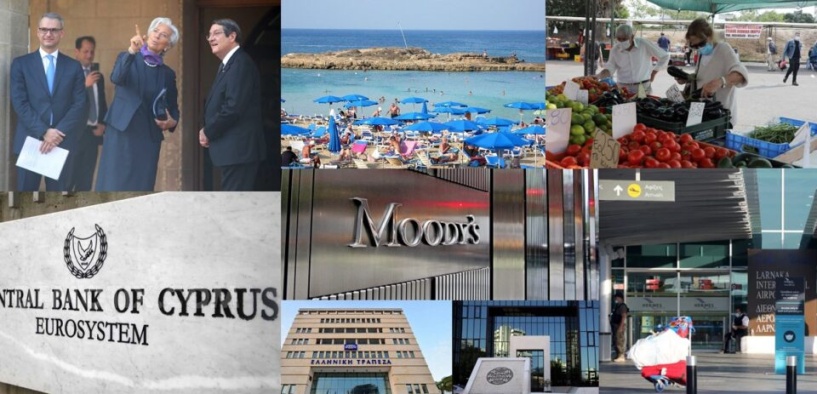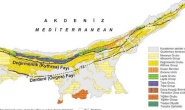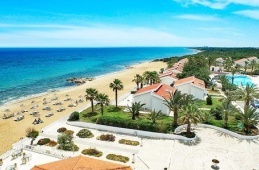The outgoing year saw a number of key events in Cyprus’ economy and business world, ranging from domestic legislation to influential international incidents
By Kyriacos Nicolaou
Resilience amidst adverse conditions
The Cypriot economy proved to be resilient in 2022, despite the many challenges posed on a global scale, which include successive years of supply-chain disruptions and suppressed economic activity caused by the Covid-19 pandemic, followed by the devastating war in Ukraine, which resulted in soaring inflation and high energy prices.
Amidst this turbulent environment, Cyprus managed to record the eighth-highest level of growth among European Union member states during the current year.
However, the Cypriot economy did not remain completely unscathed, with inflation rising here as it did elsewhere, particularly affecting the more vulnerable groups of the population.
At the same time, the state coffers filled up, boosted by both the elevated performance of certain economic sectors, combined with the aforementioned increase in prices, which, in some cases, had a positive effect on tax revenue.
Growth despite the challenges
The Cypriot economy experienced a strong growth rate of approximately 6 per cent in 2022, presenting a pleasant surprise after the Ministry of Finance’s initial estimates of 2.7 per cent.
Despite Russia’s war in Ukraine, which began in February 2022, the growth rate rose to 6.6 per cent in the first quarter of the year, 6.3 per cent in the second quarter, and 5.4 per cent in the third quarter.
For 2023, the Ministry of Finance expects the growth rate to slow down to around 3 per cent, while it is expected to rise to 3.3 per cent in 2024 and 3.2 per cent in 2025. This is perceived to be a positive development, seeing as many European countries are expecting a recession.
Additionally, in September, rating agency Standard and Poor’s upgraded Cyprus’ long-term credit rating by one notch, to BBB from BBB-, with a stable outlook, citing the diversified Cypriot economy that has proven resilient to external shocks. At the same time, Moody’s upgraded Cyprus’ outlook from stable to positive, while confirming the long-term ratings at Ba1.
The high growth rate in 2022 is also due to the recovery of the tourism sector, particularly after the pandemic.
Despite the loss of 800,000 tourists from Russia and Ukraine, which, combined, were the second largest source of tourist arrivals after the UK, tourist arrivals in 2022 reached 80 per cent of arrivals in 2019, which was a record year.
Specifically, in the period between January and November 2022, tourist arrivals amounted to 3,091,039, compared to 1,840,003 in the corresponding period of 2021.
Moreover, 621,927 tourists arrived in Cyprus between January and November 2020, while the same figure stood at a record 3,866,447 in the corresponding period of 2019.
Tourism was boosted by the increased connectivity of Cyprus, both by air and sea. Airlines increased their itineraries to Cyprus and new destinations were added, cruise companies used Cypriot ports as a base, while the reinstatement of the Cyprus-Greece ferry connection after two decades was also an important addition.
Another notable achievement during 2022 was the reduction of public debt, which is estimated to stand at 89.3 per cent of GDP by the end of 2022, marking a significant reduction compared to 103.6 per cent of GDP in 2021.
Public debt is expected to continue its downward trajectory, reaching 83.3 per cent at the end of 2023, 76.5 per cent at the end of 2024, and 72.3 per cent at the end of 2025, according to the forecasts provided by the Ministry of Finance.
In addition, unemployment is expected to have fallen to around 7 per cent in 2022, compared to 7.5 per cent in 2021.
The continued growth of the economy is expected to lead to a further decrease in unemployment to around 6.4 per cent in 2023, 5.7 per cent in 2024, and 5 per cent in 2025, a rate equivalent to full employment conditions.
Inflation and soaring prices
The sharp rise in inflation dominated the news cycle in 2022, both in Cyprus and across the rest of the world. During the first eleven months of 2022, the time period for which there is data available, the annual inflation rate stood at 8.4 per cent. This development is mainly due to the increases in oil and electricity prices, which push the prices of other goods upwards.
The surge in prices reduced the purchasing power of consumers, affecting all social classes, but especially the most vulnerable groups of the population.
The debate on the reinstatement of the cost of living allowance (CoLA), which would restore part of the workers’ purchasing power, was extended until January, since trade unions and employer organisations have diametrically opposed positions on what should be decided.
Both the Employers and Industrialists Federation (Oev) and the Cyprus Chamber of Commerce and Industry (Keve) call for the abolition of the cost of living allowance, while trade and labour unions call for its return to 100 per cent of its previous value.
What happens next?
The 2023 budget, as tabled by the Ministry of Finance and passed by the House of Parliament, is designed to create a surplus, comprised of increased development and social spending and a reduction in debt service costs. The primary surplus is estimated at 2.7 per cent of GDP.
According to the Finance Minister, the fiscal surplus is expected to widen during the three-year period between 2023 and 2025 and represent 1.7 per cent of GDP in year one, 2.3 per cent in year two, and 2.3 per cent in year three.
Furthermore, the National Resilience and Recovery Plan in Cyprus was formulated under the title ‘Cyprus-Tomorrow’. Through this plan, Cyprus is expected to absorb funds that are forecast to have an economic impact of up to €4.4 billion, including the additional private investments that will arise from the implementation of supported plans.
In addition, the plan is also expected to result in the completion of local government reform, justice reform, as well as plans to fight corruption, the modernisation and reform of Cyprus’ public service, combined with measures to facilitate the green and digital transition and the promotion of sustainable urban mobility.
President Anastasiades has described the plan as “the biggest reform and development intervention since the establishment of the Republic of Cyprus”, as it is expected to boost the growth dynamics of the economy by 7 per cent in the Gross Domestic Product in the medium term, while creating more than 11,000 well-paid jobs.
Already the disbursement of the first instalment, amounting to €85 million, was successfully completed at the beginning of December 2022.
Important developments in the banking sector
The banking sector also experienced a number of crucial events in 2022. The war in Ukraine and the sanctions imposed by the West on Russian companies and funds led to RCB’s withdrawal from the retail banking sector in Cyprus and its transformation into a supervised asset management company.
In addition, in December, Eurobank acquired a large share of Hellenic Bank. Eurobank has agreed to buy 13.4 per cent of the bank’s share capital, which was previously held by Wargaming Group.
Moreover, during the summer, there were proposals by private equity firm Lone Star for the acquisition of Bank of Cyprus, all of which were rejected by the company’s board of directors.
In addition, in an effort to reduce their operating costs, the Bank of Cyprus and Hellenic announced voluntary exit plans, which saw a total of 1,000 bank employees depart.
The Bank of Cyprus announced at the end of July that approximately 550 employees had been approved for retirement, while at the end of November, Hellenic also announced that approximately 450 of its employees had been approved for early retirement.
Importantly, non-performing loans (NPLs) decreased further in 2022, primarily due to the €1.3 billion portfolio sale by Hellenic, referred to as Project Starlight.
Furthermore, the NPLs to total loans ratio decreased to 10.6 per cent at the end of September 2022, down from 11 per cent at the end of 2021.
However, the problem of NPLs is still an issue for Cyprus, as banks may have largely reduced their portfolio exposure, yet private debt in Cyprus is still at approximately 170 per cent of GDP, including loans held by credit defaulters.
Additionally, the increase in interest rates by the ECB has led to an increase in lending rates in Cypriot banking institutions as well, with fears of a new wave of non-performing loans, as a result of borrowers’ difficulty responding, growing.
The lending rate in October was at 2.93 per cent for home purchases and at 3.59 per cent for consumer loans.
In an effort to avoid the likelihood of new NPLs being created, Cypriot banks have further tightened the lending criteria.
Important milestones in 2022
The adoption of the national minimum wage for the first time in Cyprus was considered a historic event.
After many months of discussions with all social partners, the Minister of Labour reached a decree which ensures that the minimum wage will amount to €940 for full-time employment and €885 for the first six months of employment. According to the Minister of Labour, the measure affects 40,000 workers.
In addition, at the last plenary meeting of the House of Representatives in December, the much-discussed pension plan for civil servants who entered the public sector after 2011 and for indefinite-term employees was also approved. The bill came to fill a gap that had lasted for a decade, where the above public sector workers were not entitled to pension benefits.
The issue of property foreclosures repeatedly occupied the public sphere in 2022. As of March 2020, the foreclosure law was suspended six times.
With the latest suspension approved by the House of Parliament and signed by president Anastasiades, foreclosures of residential properties worth up to €350,000, commercial properties with a turnover of €750,000 and plots of land worth up to €100,000 are suspended until January 31, 2023.
Another milestone in this year’s economic agenda was Cyprus being selected to host the meeting of the European Central Bank (ECB) for the first time, with the meeting taking place on October 5-6.
The arrival of 19 central bankers of the Eurosystem in Cyprus, along with the members of the ECB’s executive board, took place at the invitation of the governor of the Central Bank of Cyprus Constantinos Herodotou.
The discussion was not about monetary policy, but about shrinking the ECB’s balance sheet, a move called “quantitative tightening,” as the ECB has already begun its cycle of raising key interest rates in an effort to tame inflation.
ECB president Christine Lagarde previously visited Cyprus in March as well, again at the invitation of the Cypriot governor of the central bank.
In conclusion, despite the ominous outlook for the global economy, Cyprus appears to have the potential and future growth prospects that will allow it to deal with future crises.















